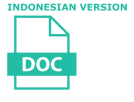Kesalahan Terjemahan Konjungtor -te pada Kalimat Majemuk Bahasa Jepang: Kajian Struktur dan Makna
Saidatun Nishfullayli(1*), Wahyu Handayani Setyaningsih(2)
(1) Sekolah Vokasi UGM
(2) UGM
(*) Corresponding Author
Abstract
In translating Japanese compound sentences, generally, students still have difficulty in interpreting the meaning of the -te verb which functioned as a conjunction (-te conjunction) in compound sentences. Semantically, the -te verb form has some meanings that can be distinguished based on the context of the sentence. Inaccuracy in determining the meaning of the -te conjunction can affect the results of translating compound sentences. In this research, the forms of -te conjunction translation errors which causes the error in translating compound sentence will be elaborated. Data in this research taken from the translation of 'Haha no Tanjobi', which is one of the subtitles in the Rudolf Beethoven biography book titled Beetoben Kodomo Denki Zenshuu, translated by semester VI students of the Japanese Language Program, Vocational College, UGM. From the analysis, the causes of errors in translating conjunctions can be concluded as follows: learners do not understand the classification of the -te conjunctions’ meaning, lack of mastery of Japanese and Indonesian compound sentence structures, and have not been able to understand the message/ meaning of each clause forming compound sentences in Japanese.
Keywords
Full Text:
PDFReferences
DAFTAR PUSTAKA
Alwi, Hasan., dkk. (2003). Tata Bahasa Baku Bahasa Indonesia (Edisi Ketiga). Jakarta: Balai Pustaka.
Larson, Mildred L. (1988). Penerjemahan Berdasar Makna: Pedoman untuk Pemadanan Antar Bahasa (Terjemahan). Jakarta: Arcan.
Masao, Hamano. (1977). Beetoben: Kodomo no Denki Zenshuu.
Masahiko, Minami (Ed.). (2016). Handbook of Japanese Applied Linguistics. Boston: Walter de Gruiter Inc.
Muhlisian, Asep Ahmad. (2013). Analisis Kesalahan Penerjemahan Bahasa Jepang dalam Karya Ilmiah Mahasiswa S2 (Tesis). Bandung: Universitas Pendidikan Indonesia (Tidak Diterbitkan).
Newmark, Peter. (1988). A Textbook of Translation. Hertfordshire: Prentice Hall Int. Ltd.
Nitta, Yoshio. (2008).Gendai Nihongo Bunpo-6: Fukubun.Tokyo: Kuroshio Shuppan.
Presada, Diana., Mihaela Badea. (2014). “The Effectivenes of Error Analysis in Translation Classes: Pilot Project”. Porta Linguarum (hal. 49-59).
Sutedi, Dedi. (2003). Dasar-dasar Linguistik Bahasa Jepang. Bandung: Humaniora.
Tomomatsu, Emoto., dkk. (2007). Donna Toki Dou Tsukau: Nihongo Hyougen Bunkei. Tokyo: Aruku.
Article Metrics
Refbacks
- There are currently no refbacks.
Copyright (c) 2019 JLA (Jurnal Lingua Applicata)

This work is licensed under a Creative Commons Attribution-ShareAlike 4.0 International License.







